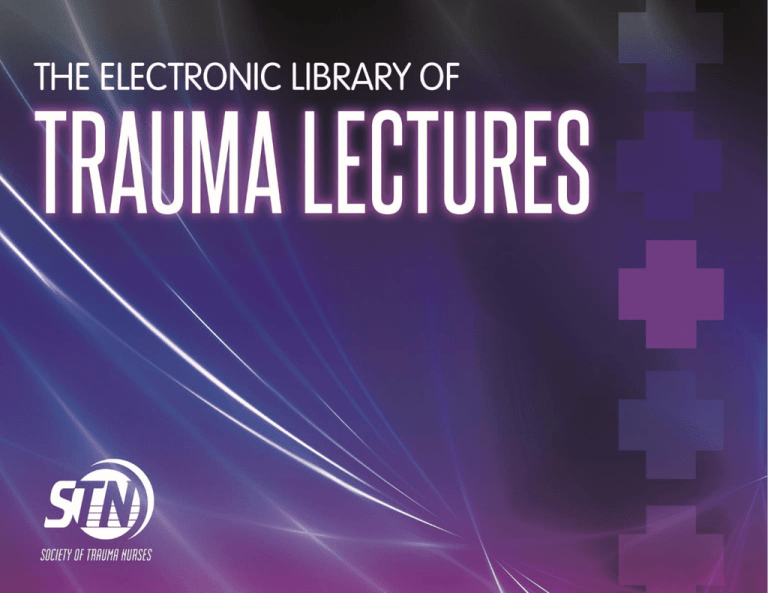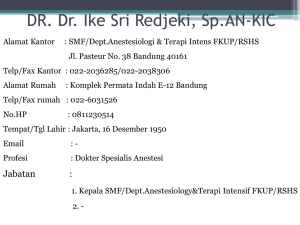Hemorrhagic Shock
advertisement

Hemorrhagic Shock Objectives At the conclusion of this presentation the participant will be able to: • • • • Recognize hemorrhagic shock signs and symptoms Explain the importance of early control of hemorrhage in trauma patients Describe the management and ongoing evaluation of hemorrhagic shock List the components of damage control resuscitation Hemorrhagic Shock • Feared by all • Respected by many • Foreign to none Time to Trauma Death • 50% deaths occur at scene within minutes: • • • • CNS injury 40-50% Hemorrhage 30-40% 50% after hospital arrival: • • • 60% die within first 4 hrs 84% die within first 12 hrs 90% die within first 24 hrs Hemorrhage accounts for 50% • Deaths in the first 24 hours Historic Trauma Trimodal Death Distribution 50% DEATH 30% 20% Minutes Immediate Hours Early Days Weeks Late Hemorrhage Trauma Deaths Civilian 40% Military 50% Trimodal Moving Toward Bimodal Death Distribution 70 Early deaths have now increased and time shifted (now < 50 min) compared to (historical of 2 hrs) 60 50 40 30 20 50 2hrs min 10 0 Immediate Historical (Pre 2000) Early Late Current (Post 2000) New Bimodal Trauma Death Distribution 60% 30% 30% 10% 4 0 HOURS 1 4 WEEKS Hemorrhagic Shock Definition Hemorrhagic Shock • Reduction in tissue perfusion below that necessary to meet metabolic needs Inadequate Perfusion Injuries Prone to Hemorrhage Vascular Solid Organ Bones Aorta Vena Cava Spleen Liver Pelvis Femur Quickly Rule Out Blood Loss Chest – CXR / FAST Abdomen - FAST Pelvis – Xray Femur – exam / Xray Fracture Associated Blood Loss • • • • Humerus Tibia Femur Pelvis 750 ml 750 ml 1500 ml >3L Associated Soft Tissue Trauma Release of Cytokines • Increased permeability • Magnify fluid loss Confounding Factors In Response To Hemorrhage • Patients age Pre-existing disease / meds Severity of injury Access to care • Duration of shock • Amount prehospital fluid Presence of hypothermia • • • • Hemorrhagic Shock Pathophysiology Heart Rate (beats/min) Preload X Stroke Volume (cc/beat) = Myocardial Contractility Cardiac Output Cardiac Output (L/min) Afterload Sympathetic Nervous System Heart Rate Contractility Vasoconstriction Sympathetic Nervous System Progressive Vasoconstriction: • Skin • Muscle • Splanchnic Bed Important Hormones in Shock Catecholamines: Epinephrine & Norepinephrine • Increased heart rate & contractility • Vasoconstriction & narrowed pulse pressure Renin-Angiotensin Axis: Aldosterone and ADH • Water & sodium conservation & vasoconstriction • Increase in blood volume and blood pressure • Decreased urine output Sympathetic Nervous System Increased shunting of blood to: Heart & Brain Cellular Response to Shock Acidosis Blood Loss Cellular Edema Lactic Acid Inadequate Perfusion Cellular Hypoxia Anaerobic Metabolism Aerobic Metabolism Hemorrhagic Shock Assessment Classic Signs & Symptoms of Shock • • • • • Changing mentation Tachycardia Cool, clammy, skin Prolonged capillary refill Narrowed pulse pressure • Decreased urine output • Hypotension Normal Vitals do not r/o Occult Hypo Perfusion ATLS Classification of Hemorrhagic Shock CLASS I BloodLoss (ml) CLASS II CLASS III CLASS IV <750 15% 750-1500 15%-30% 1500-2000 30-40% >2000 >40% HR <100 >100 >120 >140 BP normal normal decrease decrease PP normal decrease decrease decrease RR 14-20 20-30 30-40 >35 UOP >30 20-30 5-15 negligible CNS slightly anxious mildly anxious anxious confused confused lethargic % Aortic Press (mmHg) 100 15% 25% 50 I II 35% III 45% IV 60% 0 0 Decompensated Compensated Effects of Blood Volume Loss on Mean Arterial Pressure in Classes of Shock Transfusion 2 4 Time (hours) 6 Most die by 6 hrs • • • • • • • Mentation Skin Perfusion Pulse Blood Pressure Pulse Pressure Shock Index Urine Output • • • • • • pH Serum Lactate Base Deficit Echocardiography Arterial Wave Analsyis StO2 (NIRS) Endpoints Traditional vs. New Acute vs. Ongoing Static vs. Dynamic Global vs. End Organ Resuscitation Initial Assessment Assessment vs. Resuscitation Endpoints Response Fluid Resuscitation Rapid Response Transient Response No Response Vital Signs Return to normal Transient improvement Remain abnormal Estimated Blood Loss Need for more IV fluid Minimal (10-20%) Moderate and Severe (>40%) ongoing (20-40%) Low High High Need for Blood OR Low T&C Possibly Moderate Type Spec Specific Likely Immediate O Pos/Neg High EVAL Value of Manual Vital Signs Pulse Character GCS Motor Verbal Most Predictive for Need of Life Saving Interventions Rough BP Estimation from Pulse • If you can palpate this pulse, you know the SBP is roughly this number 60 80 70 80 Occult Hypoperfusion State of O2 delivery in the setting of grossly normal physiologic criteria Patients don’t suddenly deteriorate, rather we suddenly notice… Changing Mentation • • • Indicator of perfusion Affected by drugs & alcohol Hypoxia/Head Injury • Until proven otherwise Skin Perfusion • Pale, cool, mottled • Vasoconstriction • Most sensitive in pediatrics • Starts distal extremities • Ascends towards trunk • Capillary Refill • Unreliable to measure • Normal < 2 seconds Blood Pressure • BP response to volume loss • Non-linear due to compensatory mechanisms • Insensitive sign of early shock • NTDB study • SBP did not decrease < 90 • Until base deficit was > 20 • Infrequently & or inadequately monitored • First BP should always be manual • Automated BP overestimated by 10 mm Hg Blood Pressure • Systolic BP drop a late sign • Systolic BP does not fall until: • Adults 30% blood loss • Pediatrics 40-45% blood loss • SBP < 90 mm Hg: mortality approaches 65% Beware Dismissal of Prehospital BP Prehospital Hypotension Prehospital + ED Hypotension Skepticism Strong Predictor • Mortality • Need for Operation Hypotension Redefined? The New Hypotension: SBP < 110 • Associated with onset of physiologic changes • • • • Base Deficit ICU Days Ventilator Days Complications • Use only to diagnose shock • Not as resuscitation endpoint Research demonstrates that optimal SBP for improved mortality in hemorrhagic shock increases with age New SBP Sweet Spot for Early Diagnosis of Shock? Adult Trauma 60 70 80 90 100 110 120 130 Geriatric Trauma 90 100 110 120 130 140 150 160 Pulse Pressure • Narrowed pulse pressure suggests significant blood loss • Result of increasing diastolic pressure from compensatory catecholamine release 100/66 100/74 100/77 100/84 Pulse • • • Lacks specificity alone Age dependent Affected by: • • • • • Emotion Fever Pain Drugs Pulse & character together more reliable • • Trended over time may? have sensitivity When to be concerned? 80 90 100 110 > 120 Any patient who is cool & tachycardic is in shock until proven otherwise (ATLS) Relative Bradycardia (Paradoxical Bradycardia) • Defined as Pulse < 90 with SBP < 90 • Occurs in up to 45% of all hypotensive trauma • Cause remains unclear: • • • Sign of rapid & severe internal bleeding? Increased vagal tone from blood in abd cavity? Protective reflex designed to increase diastolic filing in the presence of severe hypovolemia? Shock Index (SI) • • • • SI = HR / SBP Elevated early in shock Normal 0.5 - 0.7 SI > 0.9 predicts: • • Acute hypovolemia in presence of normal HR & BP Marker of injury severity & mortality • Caution in Geriatrics • May underestimate shock due to higher baseline SBP • Uses • • Prehospital use → triage Predict risk for mass transfusion? Urine Output Adult 0.5 ml / kg / hour Child 1.0 ml / kg / hour Toddler 1.5 ml / kg / hour Infant 2.0 ml / kg / hour Hemodynamic Monitoring Central Venous Pressure Pulmonary Artery Catheter • • • • Not advocated for hemorrhagic shock Poor relationship between CVP and blood volume Unreliable for assessing response to fluid Use: • • • • Acute air embolus Acute PE Rt Ventricular infarction Acute lung injury • • • Not advocated for hemorrhagic shock Dynamic response of the systems too slow to guide therapy Use: • May benefit geriatric trauma • Sepsis goal directed therapy Doppler Echocardiography (Transthoracic or Transesophageal) • Allows for physician bedside assessment: • • • • Ventricular function Volume status Stroke volume Cardiac output • Dependent on: • • • Technology investment Technical expertise Intra-observer variability • Excellent diagnostic tool • Poor monitoring device Physiologic Variability as Predictors • Subtle patterns of variation produced by healthy biological systems is normal • Loss of this variability is seen in critical illness • Early loss of HR variability predicts mortality in trauma Arterial Pressure Waveform Systems • Measures pulse pressure & stroke volume variation • Reliable predictors of volume responsiveness • Determines where the patient lies on their own individual Starling curve Examples of systems: PiCCO (Phillips) pulseCO (LiDCO,Ltd.) FloTrac/Vigileo (Edwards) Near Infrared Spectroscopy (NIRS) Skeletal muscle StO2 • Measures hemoglobin oxygen saturation in tissue • Tracks systemic O2 delivery • Continuously and Noninvasively • Comparable results to BD and Lactate • Predicts MSOF • Predicts Mortality • Research ongoing as resuscitation endpoint Hemorrhagic Shock Lab Values Hemoglobin / Hematocrit • Unreliable estimation acute blood loss • Lag time of several hours • Baseline value for comparison only Arterial pH Acidosis - Serum pH < 7.20 Ongoing Marker of Severe Physiologic Derangement • • • • Decreased cardiac contractility Decreased cardiac output Vasodilation and decreased BP Decreased hepatic and renal blood flow Lactate • • • • • Indirect measure of oxygen debt Normal value = 1.0 mEq/L Values > 1.0 correlate to magnitude of shock Lactate Levels > 5 = ↑ mortality Ability to clear lactate within 24 hours: • Predictive of survival • Inability to clear lactate within 12 hours: • Predictive of multisystem organ failure Base Deficit • • • • • Sensitive measure of inadequate perfusion Normal range -3 to +3 Run on blood gases Admission BD correlates to blood loss Worsening BD: • • Ongoing bleeding Inadequate volume replacement Base Deficit Classification Category Base Deficit Mortality Mild <5 11% Moderate 6-9 23 10-15 44% 16-20 53% >20 70% Severe International Normalized Ratio (INR) • Test of clotting (extrinsic pathway) • Internationally accepted method of reporting prothrombin (PT) results worldwide Population Value Normal 0.8 - 1.2 Anticoagulant Use 2.0 - 3.0 Trauma > 1.5 = coagulopathy Thromboelastogram (TEG) • Measures global function of clotting components • Dynamically: clot formation to clot dissolution • Pattern recognition TEG Uses • • • • • Predicts need for transfusion Targets use of blood components Identify hyperfibrinolytic patients Assess LMWH monitoring in high risk ICU pts Assess impact of platelet inhibitors (aspirin and Plavix) with Platelet Mapping • Possibly the only method for detecting degree of anticoagulation by Dabigatran (Pradaxa) TEG • Rapid, clinician operated, point of care test • Allows for individualized quick monitoring • Where used: • • • ED, OR, Angio, ICU Flat screen monitors Project results in all areas • Large volume of research coming that will establish TEG protocols in trauma resuscitation Hemorrhagic Shock Treatment airway… breathing… circulation… Is There a Shock Position? • • Dr. Friedrich Trendelenburg 1800’s To improve surgical exposure - pelvic organs No Benefit in Shock Mechanical Means of Stopping Hemorrhage Pelvic Binders • Reduce pelvis volume • Tamponade effect Tourniquets • Studied extensively in war • Good outcomes • Safe and effective Mechanical Means of Stopping Hemorrhage Hemostatic Dressings • Research advancing quickly • • Made of volcanic rock, clay, shells Actions: • Direct compression • Activation of clotting • Adhesion • Utility • Speed of application (under fire) • Pliable, Z Fold conformation IV Access Principles in Shock • Fastest, simplest route best (antecubital) • Large bore, short length (14-16 gauge, 2inch length) • Flow limited by IV gauge & length not size of vein Optimally • Two people attempting simultaneously • Two different sites (above & below diaphragm) • Two to three sites required per major trauma • Progression [PIV → Femoral → Subclavian] • Consider Intraosseous (IO) early as rescue device Avoid IV Access • Injured limb • Distal to possible vascular wound • Femoral access with injury below diaphragm IV Access in Shock • Subclavian/Internal • 8.5/9.0 French Introducer Jug • Femoral Vein • • Side port removed ↑ flow rate Out of the way of intubation or chest procedures • • • Higher risk (pneumothorax) Lower success rate In chest injuries, place on side of injury Intraosseous Devices • • • • • • • • • Temporary access Children & adults Insert within 1 minute Manual or power drill Prox tibia/humerus/sternum Avoid fracture /injury sites Good for fluid/blood/meds Flow rates up to 125 mL/min w pressure bag Risk: extravasation → compartment syndrome Pre Hospital IV Placement in Trauma? EAST 2009 Guideline • No evidence to support IV placement at scene • Enroute OK • Limit 2 attempts → I.O. • Saline lock/Keep open • Avoid continuous IV • Use small boluses (250cc) • Titrate to palpable radial Fluid Resuscitation Fluid Administration Balance • Too little… • • • • • • Ongoing shock Continued acidosis Coagulopathy Myocardial dysfunction Renal failure Death • Too much… • • • • • Increased bleeding Clot disruption Dilution coagulation factors Compartment syndromes Transfusion concerns • Inflammation • Immunosuppression • Transfusion Related Acute Lung Injury (TRALI) IV’s & Fluid Distribution Total Body Water = 60% of Total Body Wt Intracellular (ICF) 2/3 Extracellular (ECF) 1/3 ISS IVS 75% 25% D5W NS LF 90% 0% 0% 90% 75% 75% <10% <25% <25% NS vs. LR Normal Saline • Na,Cl • Fluid of choice for blood • Con: • Hyperchloremic acidosis Lactated Ringers • Na, Cl, K, Ca, Lactate • Fluid of choice per ATLS • Con: • Immune modulation Crystalloids (Isotonic Solutions) Balanced electrolyte solutions similar to ECF Rapidly equilibrates across compartments Only 25% remain in IVS after 17 minutes! Small Volume Resuscitation Paradigm Shift • • • • • Using hypertonic/hyperosmotic fluid Remains in vascular space longer Restores vascular volume Without flooding patient Started by military → civilian trauma Examples: • • Hetastarch (Hespan/Hextend) Hypertonic Saline (3% to 7.5%) Small Volume Resuscitation: Hetastarch/Hespan/Hextend • Plasma volume expander • 500cc hetastarch expands blood volume 800cc 500ml Hetastarch Equivalent 2-3 L LR • Safe and effective at 500cc bolus • Cons: • • May cause coagulopathy in large doses (>2L dose) Renal tubular dysfunction concern Small Volume Resuscitation Hypertonic Saline Type: 3.0% and 7.5% Sodium Chloride Action: Rapidly pulls fluid from tissues into bloodstream Stabilizes BP & CO and controls ICP 250 ml ~ 1 Liter NS or LR Results: Large RCT unable to show survival benefit If it doesn’t carry oxygen or it doesn’t clot! Don’t give it to me! Packed Red Blood Cells Plasma Platelets Action Carries Oxygen No clotting factors Coagulation Factors Aggregation 1 unit ~300 ml (Hct 55%) ~250 ml ~25 ml individual unit ~150 pooled unit Dose ↑ Hgb by 1 g/dl ↑ Hct by 3 % In the non-bleeding pt ↑ coags by 2.5% (Need at least 4 u for significant change) 1 unit Apheresis (pooled) ↑ 25,000-50,000 per u Storage -4 C Non Trauma Center • Frozen • thaw time • 2 u in 30 minutes Trauma Center • Room Temp • Good for 5 days • Monitor wastage Room temp Agitated Progression: Emerg Uncrossmatched (immediate) Type Specific (20 min) Cross Matched (60 min) Blood Administration Traditional Management Emerging Management Fluid Blood Fluid Blood Give 2 Liters ↓ → Continue IV’s wide open PRBC 5-10 u ↓ Minimize 1:1 or 1:2 (Plasma: RBC) Wait for labs ↓ Plasma ↓ Platelets Protocolize ↓ Massive Transfusion Protocol Massive Transfusion Definition Old Definition New Definition 10 units of PRBC within 24 hours 10 units of PRBC within 6 hours Component Therapy vs. Whole Blood 1 u PRBC 335ml, Hct 55% 1u Plasma 275ml, 80% Coags 1 u Platelets 50ml, 5.5X1010 Total: 650 ml Hct 29% Platelest 88,000 Coag Factors 65% Whole Blood 500 ml Hct 38-50% PLTs 150-400,000 Coag Factors 100% Blood Progression in Hemorrhage Immediate Emergency Uncrossmatched O+ Males O- Females/ Peds 10 minutes Type Specific ABO & Rh Compatible 50 minutes Crossmatched ABO & Rh Type Antibodies Hemorrhagic Shock Drugs: Is there a role? Recombinant Factor VIIa NovoSeven • • • • Refractory bleeding in trauma Activates Extrinsic Pathway Off label use in trauma Research Results in Trauma: Correct before use: • Hypofibrinogenemia: • • • Numerous anecdotal reports 1 RCT published trauma: • ↓ blood use • ↓ MSOF ↓ ARDS • Trend toward ↓ mortality • No ↑ thrombotic events • • Thrombocytopenia • • Give Cryoprecipitate Give Platelets Hypothermia • Correct Temperature Acidosis • Consider Bicarbonate Factor VIIa • Include in Massive Transfusion Protocol: • • • • Do not use to early or too late Administer between 8 - 20 PRBC’s Recommended dose: 100 mcg/kg Expensive: • 100mcg X 70kg =7,000mcg = $7,700 • Repeated at 1-2 hour intervals if required Tranexamic acid (TXA) • • • Derivative of AA Lysine - inhibits fibrinolysis Inexpensive ( $80/dose) and proven safety profile Cochrane review (2007) 53 RCT’s Cardiac/Ortho • Sig reduction in bleeding without thrombotic complications • CRASH2 trial (2010) Prospective RCT, > 20,000 pts • Stat sig 1.5% reduction in mortality (overall) • Subgroup analysis (Severe bleeding & early admin) • • Reduced bleeding by 30% IF given within 1 hour MATTERs trial (2011) Camp Bastion in Afghanistan • Marked improvement in survival in most severely injured compared to those who did not receive it • Soldiers to carry autoinjectors on battlefield Tranexamic Acid (TXA) Example Protocols Military Protocol • • • • Give within 1-3 hours of injury 1 unit of blood 1 Gm of Bolus of TXA 1 Gm Infusion over 8 hrs Oregon Health & Science University Protocol • • • • MTP activated Pt has received > 4 units within 2 hours Give 1 Gm bolus Start 1 Gm drip over 8 hrs Hemorrhagic Shock Evolving Treatment Concepts Hypothermia Trauma Triad Death Coagulopathy Acidosis Hypothermia Defined: • Core Temp < 35C (95F) Action: • • ↓ coagulation factors ↑ platelet dysfunction Classification: • • Mod 32-34 C (90-93 F) Severe <32 C (< 90 F) T < 32C = 100% mortality Moderate to Severe Hypothermia Occurs In <10% of Trauma Acidosis • Effects: • • Altered hemostasis Myocardial depression • pH < 7.2 • Initial BD > 6 • Correlates with: • • Depth of shock Degree of tissue injury • • Assessed: • • • pH Base Deficit Lactate • • • Predicts transfusion Increased ICU days Risk for MSOF Initial BD > 7.5 • ↑ mortality Changing Paradigm Traditional ED OR death Damage Control ED OR ICU OR ICU Damage Control Surgery (1990’s) Stage I Initial Control of Hemorrhage Stage II Stabilization Stage III Definitive Treatment 2003 Realization That Coagulopathy Starts Early 1/3 trauma arrive coagulopathic on arrival 4X more likely to die Trauma Coagulopathy Theory Trauma Inflammation Pre-existing Disease Meds Genetics Hemorrhage Shock Resuscitation Acidosis Hypothermia Dilution Hypothermia Activation Protein C Fibrinolysis Factor consumption Now termed… Trauma Induced Coagulopathy (TIC) Acute Coagulopathy of Trauma & Shock (ACoTS) or Acute Trauma Coagulopathy (ATC) Damage Control Resuscitation Permissive Hypotension Hemostatic Resuscitation Damage Control Surgery Permissive Hypotension • Restricted fluid administration • Avoid “popping the clot” • Accepting limited period (< 2 hours) of suboptimum end organ perfusion • Titrate to Mean Arterial Pressure (MAP) Mean Arterial Pressure (MAP) • Animal studies indicate a MAP of 50-60 as a resuscitation target Fatal Hypoperfusion MAP 40 50 Pop the Clot 60 70 80 Human RCT Studies: Permissive Hypotension Bickell, 1994 NEJM Dutton, 2002 JT (Houston) • Randomized trial (n=598) • Penetrating hypotensive • EMS study (Baltimore) • Randomized trial (n=110) • Blunt + Penetrating hypotensive • Emergency Department study EMS Fluid EMS No Fluid ED SBP 80 ED SBP 100 62% Survival 70% Survival 92% Survival 92% Survival Permissive Hypotension RCT Intraoperative Morrison, 2011, J of T (Houston) Prelim Results • n=90 Blunt & Pen, Hypotensive, To OR for chest or abd • Maintaining target minimum MAP 50 vs. 65 • Results: Hypotensive resuscitation is safe Decreased Coagulopathy and early death BP Measurements Systolic 120 Diastolic 80 Pulse Pressure 40 MAP 93 115 110 105 100 75 75 70 70 40 35 35 30 88 87 82 80 95 90 85 65 60 55 30 30 30 75 70 65 80 75 70 65 50 50 45 40 30 25 25 25 60 58 53 48 60 35 25 43 Normal MAP 70-100 Coming Soon? New Target MAP 50-70 Geriatric Patients? Traumatic Brain Injury? Hemostatic Resuscitation • Early diagnosis in ED • 1:1 ratio (PRBC to FFP) • Early frequent: • • Cryoprecipitate Platelets • Minimal crystalloids • Stop the bleeding Blood Loss ATLS: After 20 years of high volume fluid resuscitation Chasing tachycardia Using Crystalloid > Blood Little evidence of improved survival Current consensus: Damage Control Resuscitation • Permissive Hypotension • Hemostatic Resuscitation • Damage Control Surgery New Treatment Paradigm Resuscitate Stop The Bleeding Component Therapy vs. Whole Blood 1 u PRBC 335ml, Hct 55% 1u Plasma 275ml, 80% Coags 1 u Platelets 50ml, 5.5X1010 Total: 650 ml Hct 29% Platelest 88,000 Coag Factors 65% Whole Blood 500 ml Hct 38-50%, PLTs 150-400,000 Coag Factors 100% Hemorrhagic Shock Putting it all together! Prehospital Fluids EAST 2009 Guideline Penetrating Stable (pulse/coherent) No Fluids Penetrating Unstable Titrate 250ml Boluses: radial pulse/coherent Traumatic Brain Injury Titrate 250ml Boluses: SBP >90 (MAP>60) Identifying The Patient At Risk In ED • • • • • • • High ISS SI > 0.9 SBP < 90 mm Hg Acidosis Base Deficit > 6 Hypothermia T < 35C (95 F) INR > 1.5 Elevated Lactate Required Labs For Major Activations: • ABG • BD • Lactate • INR Putting It All Together Hemorrhaging (Non TBI) SBP 80-90 TBI SBP > 90 Hemorrhage + TBI No Recommendation Summary • • • • • • • Assess for coagulopathy early LR is fluid of choice in trauma Utilize Massive Transfusion Protocol Small volume resuscitation techniques Consider Tranexamic acid and Factor VIIa Correct acidosis and hypothermia STOP THE BLEEDING!





![Electrical Safety[]](http://s2.studylib.net/store/data/005402709_1-78da758a33a77d446a45dc5dd76faacd-300x300.png)



